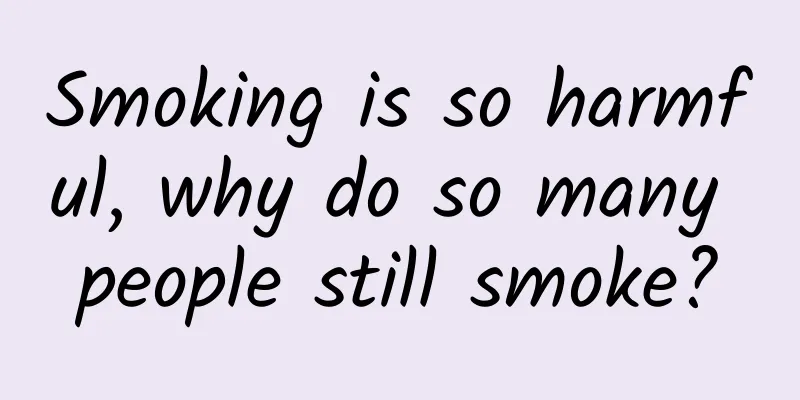Smoking is so harmful, why do so many people still smoke?

|
On World No Tobacco Day on May 31, a public service promotional video "Smoked Lung Slices" went viral on the Internet, sparking heated discussions among people and becoming a highlight of smoking cessation propaganda! Although the promotional video is only one minute long, it vividly reflects the changes that occur to the lungs after tobacco enters the human body. In the end, the originally pure lungs seem to be splashed with ink. . . . . Such promotional videos are shocking to people. Many people even set a flag of "never smoking". Some netizens forwarded the video to old smokers around them to arouse their awareness of quitting smoking. Yes, although the harm of tobacco is well known, this long-term chronic harm is not enough to attract people's attention. This is also part of the reason why many people do not pay attention to quitting smoking. So, why do people smoke? What are the harms of smoking? How to quit smoking scientifically? Let's share with you today. First of all, why do people smoke? I guess many people would wonder what's so good about cigarettes and why so many people smoke. For example, in 2018, the smoking rate among people aged 15 and above in my country was 26.6%, among which the male smoking rate was as high as 50.5%, which is higher than the international level. Actually, there are two reasons: 1. Smoke, has a fragrance. Although many people do not like the taste of tobacco, there are also many people who like it. Moreover, as a substance that contains many aromatic ingredients, tobacco will release some fragrance when it burns, and these fragrances will attract people. 2. Tobacco can actually make people happy This is also the reason why tobacco eventually causes people to become addicted. There is a key substance in human nerves, the acetylcholine receptor. This substance is the binding partner of the neurotransmitter acetylcholine, which is used to transmit nerve signals. It is the basic substance of our nerve transmission and plays a core role. Our various daily neural interactions are more or less related to this substance. And, things that make people happy are even more out of the question. For example, in our neural reward center, the binding of acetylcholine causes the release of dopamine, which makes people excited. Then the receptors are released, dopamine is reduced, and the excitement is restored [1]. And there is an important substance in tobacco: nicotine. This simple molecule is one of the main components of tobacco. In fact, nicotine itself is nicotine, which is found in all Solanaceae plants, including tobacco. This substance is actually toxic. The secretion of nicotine can be used for sterilization and immunity, etc., which can help tobacco resist the harm of nature and allow itself to survive better. However, tobacco may not have thought that it would be used by humans for smoking, and the result is that nicotine came into the human body. The emergence of nicotine changed this situation. Nicotine is a competitor of acetylcholine and it can also compete for acetylcholine receptors. In this case, in order to cope with the lack of acetylcholine receptors in the body, more acetylcholine receptors will be generated. As a result, when smoking, nicotine will continue to bind to acetylcholine receptors, thus producing continuous excitement in the brain. (Diagram of nicotine producing excitement) You can say that nicotine is a stimulant to some extent. Of course, many people will not refuse something that makes them happy. However, this is a trap!!! When you start to use nicotine, it means that your brain has more acetylcholine receptors and expands its capacity. However, this also means that you need more stimulation to get excited. Once you give up smoking, the extra acetylcholine receptors will remain vacant, resulting in a strong desire for tobacco, which is the so-called withdrawal reaction. (Nicotine Addiction) The so-called withdrawal symptoms are a psychological phenomenon, which mainly refers to the strong discomfort or even the opposite of the drug effect after stopping the use of drugs [2]. Of course, this situation is not only applicable to drugs, but also to some of our daily foods such as alcohol, tobacco, etc., and even behaviors such as playing games. It is a result of "addiction". However, withdrawal reaction is not a purely psychological phenomenon, but a phenomenon closely related to physiology. For tobacco, withdrawal reaction also exists, and the main factor behind it is nicotine. 2. Harms of Tobacco The most harmful part of ordinary cigarettes is tar, which refers to the brown greasy substance left in the mouthpiece during smoking, commonly known as tobacco oil. A very intuitive change during smoking is that the color of the filter gradually darkens as you smoke, and the fingers holding the cigarette will also change color due to the smoke. Of course, after smoking, the teeth will also be stained with a dark layer, and the root cause is tar. Tar is not just a color change. In fact, it is the product of incomplete combustion of organic matter under oxygen-deficient conditions. Therefore, it contains a lot of substances, many of which are carcinogens, such as benzopyrene, cadmium, arsenic, beta-tetracycline, amines, nitrosamines and other carcinogens and phenols, fumaric acid and other carcinogens. Because of this, ordinary tobacco has become a Class I carcinogen listed by the International Agency for Research on Cancer under the World Health Organization, which means it is clearly carcinogenic. In addition, tobacco tar can also accelerate the aging of human blood vessels, causing the blood vessels to gradually harden and lose elasticity, leading to cardiovascular disease. Many other diseases are often caused by tar, so the first suggestion from doctors for many diseases is to quit smoking. So is there no solution to tar? The answer is basically yes, there is no solution to tar. Someone once became a tobacco academician by reducing tar, but encountered a lot of opposition, including hundreds of academicians writing a joint letter to the country to cancel his qualifications. Yang Gonghuan, director of the China Tobacco Control Office, said that the "harm reduction and tar reduction" method of cigarettes is a scam that kills people efficiently. Many studies at home and abroad have long shown that "low tar" is not "low harm", and the "tar reduction and harm reduction" of cigarettes is itself a false proposition, and any "achievements" based on this are untenable. Moreover, the consequence of low tar is that it causes users to smoke on a larger scale, and finally the harm is aggravated. 3. How to quit smoking scientifically? Although there are many theories about quitting smoking, most of them are based on willpower. However, there are also some medical methods. In the "Chinese Clinical Smoking Cessation Guidelines" [3], a total of three drugs are recommended. These are also the drugs currently approved by my country's CFDA. They are: 1. Nicotine patches and nicotine chewing gum (over-the-counter drugs). 2. Bupropion hydrochloride sustained-release tablets (prescription drug). 3. Varenicline (prescription drug). These three drugs are actually divided into two types. The first type: replacement therapy - nicotine patches, nicotine chewing gum This method of quitting smoking is actually a gradual relief process. Taking into account the strong reactions of tobacco addicts, a gradual reduction in dosage is used to achieve the goal of reducing addiction. Since nicotine products themselves contain nicotine, they can supplement smokers' needs for nicotine to satisfy those acetylcholine receptors, acting as a transition and buffer, so that smokers who quit smoking will not have strong withdrawal reactions. This is better than relying solely on willpower to resist. After all, change is difficult for everyone, especially when it involves the central nervous system's own need for nicotine, which helps to get through the suffering of the stage. The second type: direct blocking - bupropion hydrochloride sustained-release tablets, varenicline For patients with severe smoking addiction, neurological drugs may be used. The two prescription drugs recommended in the "Chinese Clinical Smoking Cessation Guidelines" are both psychotropic drugs that act directly on the nervous system. Bupropion hydrochloride sustained-release tablets are well-known antidepressants, and varenicline acts on the acetylcholine receptors mentioned above and is a partial agonist of the nicotinic acetylcholine receptor α4β2. The above two substances have strong psychotropic effects and many toxic side effects. They can cause mental disorders such as depression and may even cause suicide [4]. This is also an important factor in the strict control of such psychotropic drugs in many countries. my country has listed them as prescription drugs, and they must be diagnosed in a hospital, and then prescribed by a doctor and used under the supervision of a doctor. The above are all drugs mentioned in the official guidelines. They are also official drugs that have been studied and approved by multiple departments. They have undergone many studies and are therefore relatively safe choices in all current channels. Finally: Overall, smoking addiction can be quit. Countless people have demonstrated this, so everyone must have confidence. Of course, quitting smoking is painful. It is not only a test of willpower, but also a physiological barrier to the binding of acetylcholine receptors in our brains, which can be said to be even more difficult. This is also the fundamental factor of the withdrawal reaction. Be determined, strengthen your will, and use smoking cessation auxiliary drugs to relieve withdrawal symptoms, and strive to successfully quit smoking as soon as possible. Finally, all friends who smoke and do not smoke, repeat one sentence: Smoking is harmful to your health, cherish life and stay away from tobacco! 1 Benowitz, Neal L. "Nicotine addiction." New England Journal of Medicine 362.24 (2010): 2295-2303. 2 Hughes, John R., and Dorothy Hatsukami. "Signs and symptoms of tobacco withdrawal." Archives of general psychiatry 43.3 (1986): 289-294. 3 National Health and Family Planning Commission of the People’s Republic of China, Chinese Clinical Smoking Cessation Guidelines (2015 edition). |
<<: Why do dragonflies fly low on cloudy days? Are dragonflies animals?
Recommend
Introduction to complex endometrial hyperplasia
In order to prevent the occurrence of complex end...
What medicine should I take for uremic infection?
Urinary tract infections in women are very common...
Why is knife fish so expensive? Is knife fish the same as hairtail fish?
As we all know, there are many kinds of fish. Dif...
Is it good to grow hibiscus indoors? How to grow hibiscus vigorously?
Amaranthus rubra is a highly ornamental flower, a...
If you don't get up and move around, your organs will get stuck together.
"I just had surgery, I need to rest well...&...
Female tubal ligation site
Some women, in order to avoid long-term use of bi...
Is cupping good for confinement?
Giving birth to a child is extremely physically d...
My period has not ended for 20 days. What's going on?
Due to the unique body structure of women, women ...
Can breastfeeding women eat leeks?
During breastfeeding, women pay great attention t...
How long will it take for 37 weeks of swollen feet to give birth?
How long will it take to give birth if there is e...
Skin picture of high bile acid
After a woman becomes pregnant, the body's ho...
What is the cause of the lump in the breast?
Women are prone to many breast diseases. When tre...
Is it dangerous if the placenta covers the cervix?
When the embryo covers the cervical opening, it i...





![[Health and wellness] Today is the end of the dog days! The 29 "dangerous" days of the year are here, learn some health knowledge to stay safe!](/upload/images/67f1e09bbd3b7.webp)



